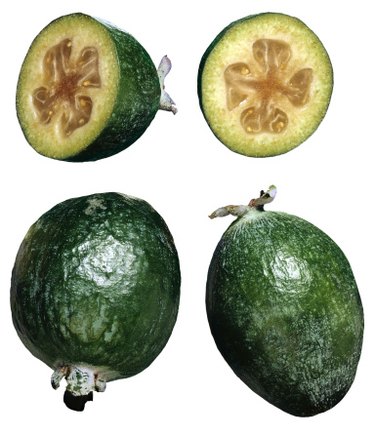Things You'll Need
Chlorine bleach
Water
Knife
Paper towel
Grafting tape

The guava tree's scientific name is Psidium guajava L. This tree thrives in tropical areas, such as India, South America and the Philippines. It grows to an average height of about 33 feet and produces juicy fruits that exude a sweet, musky odor. A grafting technique known as patch budding is a common method of propagating these fruiting trees.
Step 1
Select a strong, upright specimen for your rootstock. This portion of your grafted plant will provide the structural strength for your fruiting portion. Graft your guava during the active growing season, when your trees contain numerous leaf buds.
Video of the Day
Step 2
Clean your work area with a mild disinfecting solution that contains one part chlorine bleach to nine parts water. Wipe down your countertop and tools with this solution to prevent the introduction of bacteria and disease organisms into your graft.
Step 3
Remove a bud specimen from your scion. The scion is the portion of the graft that forms the foliage and fruit on your propagated trees. Select an area of bark that contains a healthy, new branch bud and has approximately the same thickness as the bark on your selected rootstock. Use a sharp knife to cut out the new branch bud. Slice through the bark around the selected bud, creating a rectangular shape that includes between ½ inch and 2 inches of bark around the sides of the young bud. Cutting through the layer of bark will release the portion containing the bud. Lay a damp paper towel over the detached bark and bud to keep it moist.
Step 4
Cut a portion of bark from your rootstock specimen, approximately 1 to 3 feet above the ground. Cut a small area of bark that matches the size and shape of your scion. Peel the bark off to expose the inner stem.
Step 5
Fit the segment of bark that contains the leaf bud into the wound you created in the bark on the rootstock. Press the bark patch firmly in place. Wrap the upper and lower portions of the bark patch with grafting tape, leaving the leaf bud exposed to the air.
Step 6
Water your guava tree regularly to keep the soil slightly moist throughout the area of the roots. Watch for new growth to appear in your grafted scion. This new growth is the sign of a successful graft. Cut off the upper portion of the rootstock specimen after the grafted bud produces 3 to 4 inches of new growth.
Tip
Protect your grafted guava tree from strong winds, especially during the first year of growth.
Video of the Day